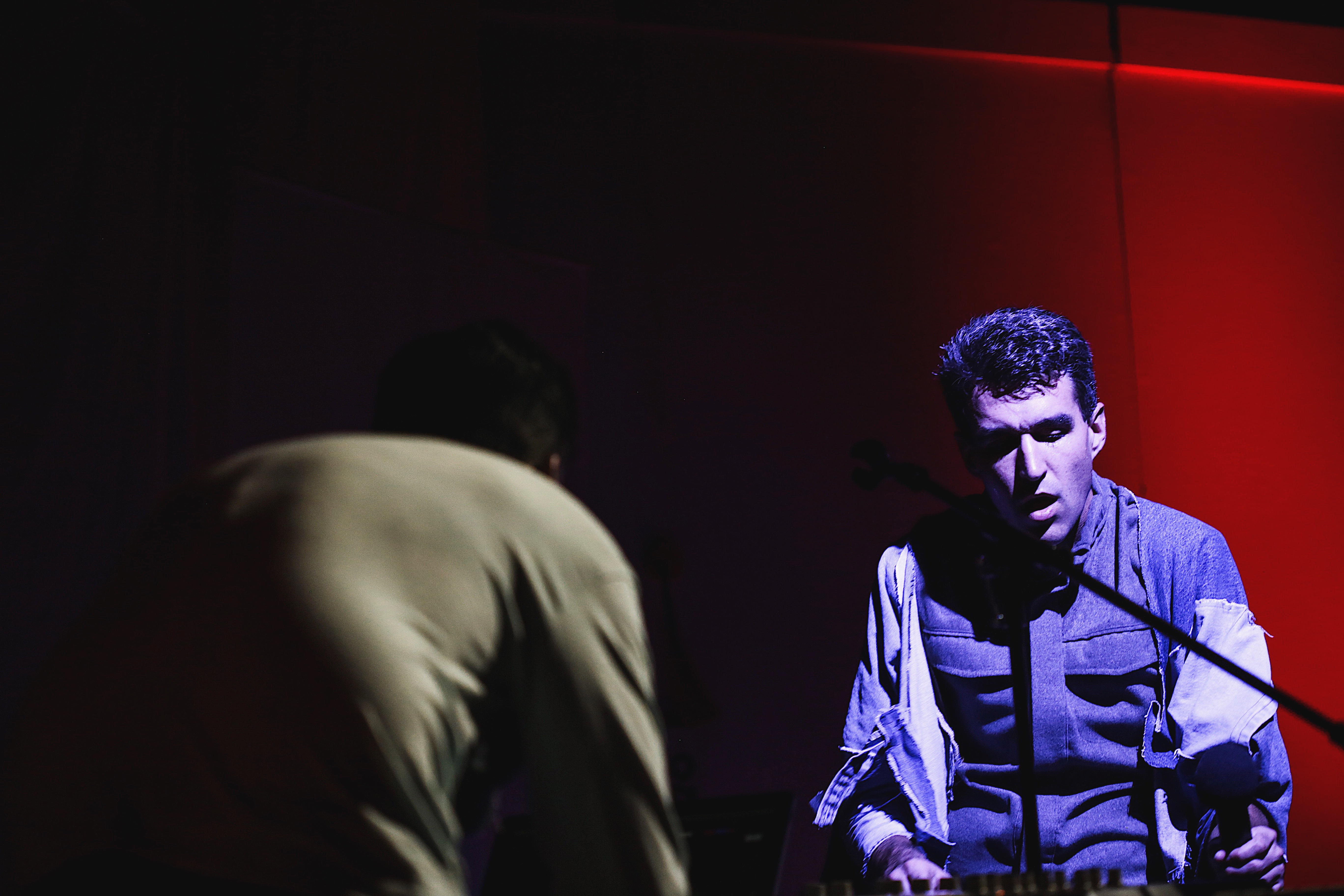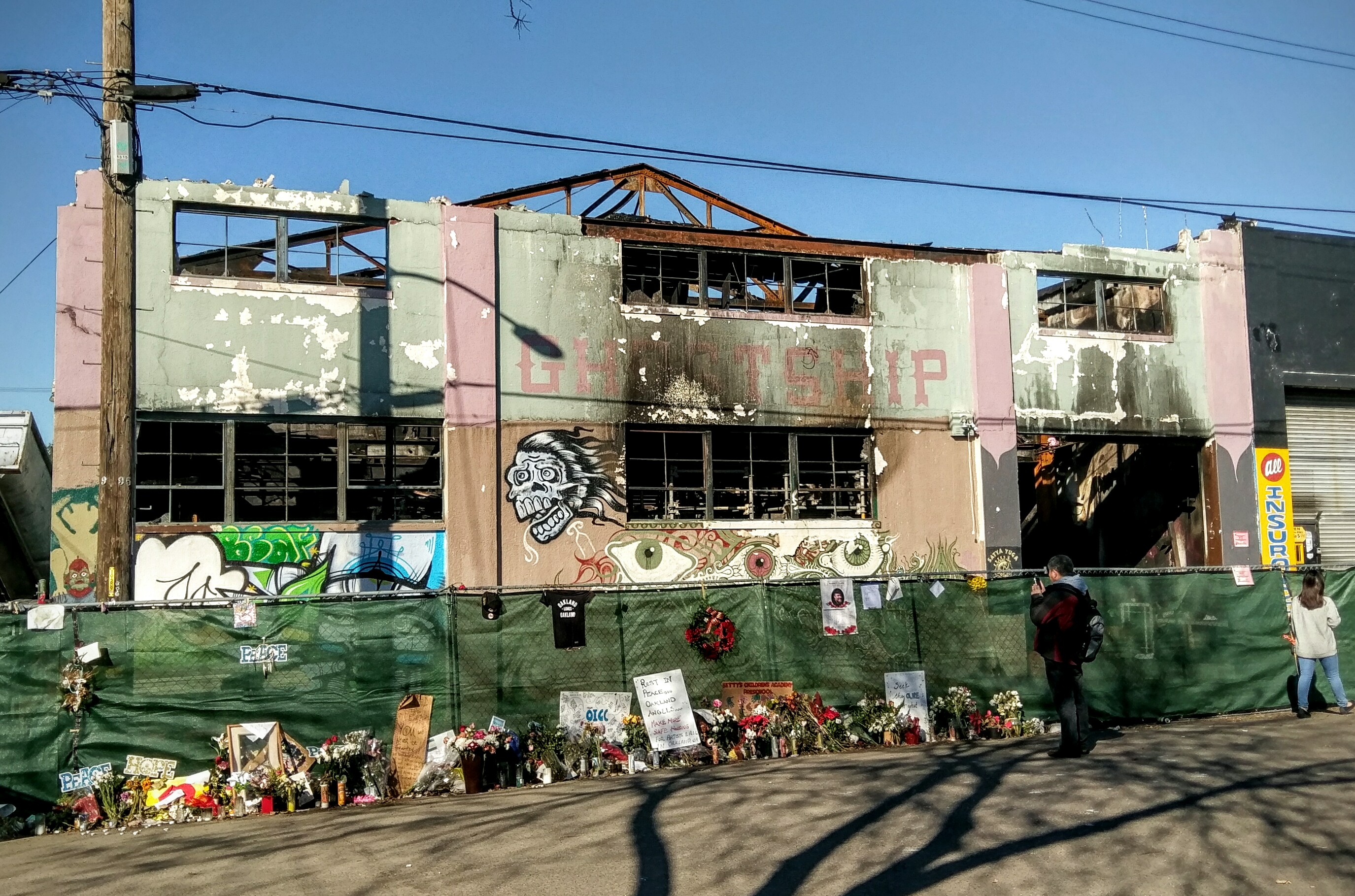Two years ago, on the night of December 2nd, 2016, 36 people lost their lives in a tragic and preventable warehouse fire, which broke out in the middle of a concert on the second floor of the Ghost Ship arts performance and living space in Oakland, CA. The fire trapped concertgoers on the second floor of the warehouse space with only a single narrow stairway as an exit, as the other stairway had been blocked off for the event. The tragedy immediately reached national news. I remember the news stories updating, the slow, awful revelation of the extent of the loss of life. I also remember that as the night went on, my social media feeds began to fill with personal outpourings of grief from friends who had lost loved ones that night. This was not an anonymous, distant tragedy. This was an extension of my community.

Photo of Ben Martin by Jared Bullis
DIY and informal arts spaces were a mainstay of my youth and young adulthood, as a performer, audience member, and event
producer. Informal arts spaces and communities have supported me and many others through tumultuous periods of our lives; provided a sense of home and acceptance that were hard to find elsewhere; and opened up radical avenues of inclusion, expression, and community. I owe much of my understanding of what it means to be civically involved—to be a part of a community—to these spaces and people. My story is not unique.
In the wake of the Ghost Ship fire, I witnessed participants in these communities and the world at large grappling with serious questions about informal, “DIY” arts spaces. These spaces often exist in a murky grey area of legal occupancy and use, yet also provide much value to participants in the way of sense of belonging, support networks, opportunities for expression, and amplifying values like tolerance and acceptance. Informal arts spaces and activities almost by definition are difficult to measure or even identify. If these spaces and communities are indeed cultural assets, how might they be identified and supported? In hot housing markets around the country, how can safety be enforced without dramatically increasing the economic threat of displacement for these already marginalized communities? Who uses these spaces? In other words, are these communities marginalized? What of the stereotype of the “young, white and privileged artists” who supposedly make up these spaces and communities? Was the lack of care or concern about safety and the disrepair and disorganization at the Ghost Ship warehouse the rule or the exception for DIY arts spaces? If Ghost Ship was the exception, how was the tragic fire used to re-strategize enforcement of these spaces around the country on the one hand, and on the other hand, how might this event be leveraged as a galvanizing point to articulate the value these spaces and communities provide?
Less than a day after Ghost Ship, fire marshals and code enforcement officials in cities around the country began to increase pressure on informal arts spaces by staging surprise inspections that led to citations and even eviction, in many cases. Spaces in Oakland and as far-flung as Denver, Detroit, and Baltimore, received such inspections in the days following the fire. Spaces like Redmond, CA’s Burnt Ramen and Denver’s Rhinoceropolis, were shut down for non-life-threatening compliance issues that had been previously overlooked for years. The residents of Burnt Ramen, many of whom were close with victims of the Ghost Ship fire, were dealing with imminent eviction-threat even before they had had a chance to attend their friends’ funerals. Enforcement officials in many cities faced pressure from politicians and the public to take no chances with these spaces, and to enforce code to the letter of the law. Advocates and participants in these communities, however, were quick to suggest that eviction would lead to the dissolution of these communities. They argued that the weight of enforcement was falling on spaces that were safer than Ghost Ship, and that up until that point had better and more cooperative relationships with their local safety and code officials.
Oakland’s mayor, Libby Schaaf, responding to cultural community members and spaces facing increased displacement threat in the wake of the fire, attempted to strike a balance between code enforcement and triggering displacement in an early 2017 executive order, where she states that “In many cases, tenants of these former warehouses and industrial buildings have long remained silent in the face of unresolved safety issues because alternative housing and workspaces are unaffordable and there is a high degree of anxiety concerning displacement or fear of eviction in response to their seeking life safety improvements.” The executive order laid out extended compliance timelines for spaces that did not represent an immediate life safety threat, as well as other strategies intended to support informal cultural communities.
In a letter to Seattle’s mayor responding to the Ghost Ship fire, the Seattle Arts Commission went even further, emphasizing that “the reactionary shutdown of essential community spaces is not an appropriate, sustainable or equitable response. Even when the intention is to protect the public by preventing imminent catastrophe, eviction creates another emergency: the violence of displacement.” The Seattle Arts Commission assertively and clearly identifies an overlap between informal arts communities and other marginalized communities including communities of color, low-income communities, and LGBTQ communities. They argue that “DIY, independent spaces… are safe havens for many of our marginalized neighbors, as evidenced by the youth, transgender people, and people of color who perished in Oakland.”
A recent Guardian article that considers the legacy of Ghost Ship also confronts the “stereotypes of young, white and privileged artists in Oakland warehouses.” The article reports that “organizers [in these spaces] said they mostly worked with vulnerable low-income tenants, including longtime older residents who have nowhere else to go.” The article goes on to profile the Alena Museum, a black-run West Oakland community arts space dedicated to Afrofuturism, the African diaspora, and combatting gentrification. Founder Hager Seven Asefaha’s landlord recently decided not to renew the space’s lease, specifically citing concern about another Ghost Ship fire-type event, despite the Alena Museum being permitted by the City of Oakland to operate as an art gallery.
The Ghost Ship fire illuminated and amplified a dual, perhaps somewhat contradictory, imperative for cities around the country: to enforce life safety and building code, in order to avoid another such tragedy, but also to provide support for these vulnerable communities, reduce displacement risk, and encourage the authentic and organic flourishing of culture and community. Landlords were incentivized to avoid the risk of such an event, a matter complicated by the fact that many of these evictions could and did occur in gentrifying areas, arguably incentivizing landlords to move out low-income occupants even further.
Occupants, organizers, and participants in these spaces also took action. Ed Bernbaum, the father of Ghost Ship victim Jonathan Bernbaum, founded Vital Arts, an organization that leverages donations and funding from the tech industry in support of safer informal and low-income Bay Area arts spaces. Safer DIY Spaces, also formed in response to the Ghost Ship fire, is a “coalition of architects, artists, contractors, and community organizers” who provide technical assistance, life safety and code guidance, and funding to DIY spaces outside of the legal liability framework that city officials must operate within.
The New York City Artist Coalition, who also formed in the aftermath of Ghost Ship, was part of the successful push to repeal the city’s infamous Cabaret Law, which had been historically used to increase pressure on cultural spaces that serve communities of color and LGBTQ communities. Their slogans—“Protecting spaces for being you” and “Culture is born in small, diverse spaces”—get at the heart of what is so important about DIY and informal arts spaces and communities. For many, these spaces are safe havens for being themselves, through expression and identity. That effect ripples out from these communities and spaces to shape the identity and character of the cities they exist in.
I got involved too. In the days following the Ghost Ship fire, I reached out to my local alternative arts space in Austin, TX, the Museum of Human Achievement, and asked how I could help. Although Austin was thankfully spared the more extreme punitive enforcement reactions experienced by spaces in other cities following Ghost Ship, they too had received a “surprise” inspection in the week following the tragedy. The conversations that we had then led us to form SPACE—Supporting and Preserving Austin’s Creative Ecosystem—a group of volunteers who support and advocate for low-income and informal arts and cultural spaces in Austin, where increasing unaffordability threatens the creative communities that the city has built its reputation on (think: “Keep Austin Weird” and “The Live Music Capital of the World”). Our current projects include pushing for additional auxiliary space allowances for creative purposes, and an anonymous web portal that would allow spaces to access critical life safety information and advice without triggering a full code review that might financially threaten the existence of these low-income spaces.
How should cities support and regulate these communities? No easy answer exists. People running these spaces are incentivized to avoid contact with city officials, or else potentially face unexpected and hefty fines, fees, or required improvements. In most cities, a life safety inspection can’t be initiated without triggering a full code review. These spaces and the value they provide are difficult to measure. All of this makes it difficult for cities to accurately assess cultural, social, and economic impact, and displacement threat.
The Ghost Ship fire brought into stark relief the needs of and threats to informal arts spaces and communities around the country. The political urgency that immediately followed the tragedy has waned somewhat, both from cities and grassroots organizers, yet the underlying issues—displacement risk, wider cultural support, and the ways that cultural organizations do and don’t overlap with other marginalized communities—remain.

